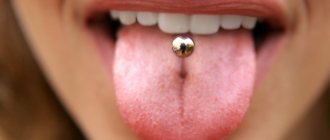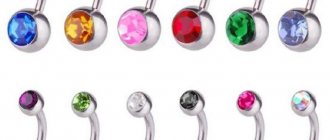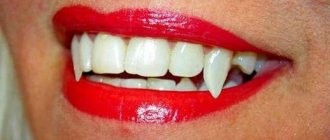Piercing is a fairly common procedure. She no longer causes strong bewilderment and ugly thoughts among those around her. But people still have disputes and misconceptions when they hear about piercing of the nipples or genitals, as well as the tongue. Many people do tongue piercing these days. The reasons for this are varied. But before you make an important decision and come to a specialist to pierce your tongue, you need to determine whether this operation is necessary and whether it has contraindications.
The history of piercing
For the first time, residents of African tribes and Polynesia began to practice the procedure of piercing various parts of the body. The Maasai were the first to introduce various decorations into their ears and lips. At that time, it was believed that the larger the size of the jewelry in the body, the greater the “weight” a person had in the tribe.
Navel piercing first appeared in Egypt. Women loved this procedure very much. The presence of a hole in the navel area of the Egyptian woman indicated that she belonged to “high society.”
In Tsarist Russia, sailors preferred to pierce their earlobes and wear voluminous earrings. Such a “symbol” meant that the person crossed the equator or belonged to the Cossack family. Later, starting in the 80s, it became fashionable for rappers to pierce their earlobes.
Nose piercing first appeared in India. The presence of a septum piercing (a puncture of the nasal septum) in a woman indicated her marital status, that is, that the girl was married.
Nipple piercings were done by warriors of Ancient Rome. An earring in a man's nipple indicated his masculinity, courage and determination. Only the strongest and bravest warriors had the right to have nipple piercings. Those with nipple earrings regularly competed in strength and courage. In order not to damage the “decoration”, special fabric capes were worn over the earrings.
The ancient Aztecs and North American tribes first began piercing their tongues. They carried out the procedure consciously, since it was considered a magical rite that helped to reunite with the Gods. The protruding blood on the tongue was considered sacred; it served as a means of calming the Spirits.
These days, piercings have completely different purposes. By piercing various parts of the body, people want to show their individuality, attract attention or stand out. For some, piercing is a way to feel new emotions, to prove to themselves that they can overcome pain and, as it were, move to a “new level of development.”
Types of needles
There is a wide variety of needles that have different diameters and purposes. Below are the types of piercing needles that are most often used for the procedure.
Designed for piercing the ears and nose. It is worth noting that these types of piercings are the most popular among many people. The instrument used to perform the puncture has an internal diameter of 0.8 mm.
This type of needle has diameters of 1.4 mm and 1.2 mm. These sizes also allow this needle to be used for nose and ear piercings. Nose piercing is carried out in different parts, for example, on the bridge of the nose or the tip, and have different decorations. Using this needle, the earlobe, cartilage, outer part of the ear or the helix of the auricle can be pierced.
It is a tool whose outer and inner diameters are 2 and 1.6 millimeters. With the help of such a needle it is convenient to pierce the eyebrows. The decoration can be placed in different places, for example, above the eyebrow, and at different angles. It is worth noting that the choice of location is determined not only based on individual wishes, but also on physiological characteristics.
Thanks to the sizes of 2 and 1.4 mm, piercings are carried out in the navel, tongue and nipples. Instruments for these types of piercings have a catheter that allows you to insert the jewelry into the hole.
This type of special needle is mainly used for setting tunnels. This is due to the size of the instrument, which has an outer diameter of 4 mm and an inner diameter of 3.8 mm. The procedure for installing tunnels involves making a hole for decoration, which will gradually stretch to the required size.
Piercing should be performed only with high-quality needles that are made of material that does not cause an allergic reaction or irritation. It is worth noting that not only the piercing process, but also the further healing of the wound depends on the instrument used.
Source
Tongue piercing procedure
Tongue piercing is a surgical procedure. Although it is short-lived, it can be very dangerous to health, and in certain cases, to life. The procedure is a sharp puncture of the soft mucous membrane of the tongue with the further introduction of a special earring or barbell.
Among the huge variety of “decorations”, the most common are vertical rods cast from medical titanium or steel. In appearance, the earring turns out to be double, that is, it can be seen both from above and, if you lift your tongue, from below.
Another popular type of piercing is the frenulum. This procedure for introducing a frenulum into the tongue is less painless; during the operation, the client releases less blood, and, accordingly, healing of the wound surface occurs much faster.
Other "decorations":
- rings;
- carnations;
- staples.
Purpose of piercing
People who decide to have their tongue pierced have different goals. It is widely believed that the presence of an earring in the soft tissue of the tongue improves sexual satisfaction in a partner. Young girls often decide to have their tongue pierced simply to become fashionable. Some people pierce a part of their body in order to show others that they belong to a certain subculture.
Tongue piercing helps people stand out “among the crowd,” to indicate that they are not like everyone else, and to prove their own uniqueness and individuality.
Tongue piercing – what consequences can a fashionable hobby lead to?
Piercing various parts of the body is a fashionable hobby that has become popular among young people for quite some time. Many people choose the tongue as the place for the piercing, since here the earring can always be hidden from prying eyes, for example, while studying or working. But it should be understood that decorating an organ presupposes its inevitable injury. Without a careful and responsible approach to the healing period, an infection can get into the wound, and problems cannot be avoided. Today we’ll talk about how piercing is done, what unpleasant consequences can occur, and what to do if your tongue hurts badly after the piercing.
Advantages and disadvantages
The presence of an earring in a person's tongue always attracts everyone's attention to him. The corresponding procedure can be treated both poorly and well. But almost always the presence of a puncture arouses interest among others.
Anyone who agrees to have their tongue pierced feels special, different from everyone else. In this way a person wants to show his individuality. And some people decide to get piercings in order to show their decisive character or, conversely, to overcome themselves.
Pros of a puncture
- After the procedure, a person begins to consider himself liberated, courage and determination appear in his character. Anyone who decides to have their tongue pierced “challenges” a monotonous and boring life.
- Tongue piercing is not as noticeable to others as, for example, eyebrow piercing. If necessary, the “decoration” can be removed, and no one will notice the presence of a puncture.
- Improves sexual sensations for a partner. When kissing or performing oral sex, tongue piercing can add additional sexual arousal and add a sense of exoticism to sexual contact.
- After surgery, a long recovery period is required. At this point, you need to follow a strict diet and give up a large list of foods. This restriction helps some people lose weight.
- If all the basics of proper care are followed, the risk of complications is minimal.
- The ability to remove the “decoration” at any time and ensure that the tongue piercing is healed. Thanks to active regeneration of soft tissues, the puncture heals very quickly.
Flaws
- The procedure is very painful. If a person is very sensitive to pain, then it will be difficult for him to undergo such an operation.
- The recovery period, which can “stretch” for several months, also brings a lot of inconvenience. The healing process of the wound surface provokes pain and physical discomfort. It can take from 3 to 6 months before all the unpleasant sensations end.
- Piercing needs to be done only in a specialized clinic or salon, and always by an experienced and qualified master. Many people pierce various parts of the body at home. But in this option, the risk of developing dangerous complications increases sharply. Saving on your own health can cost much more than the cost of surgery in a trusted clinic.
- There is a risk of infection. This often occurs due to the use of unsterile instruments during surgery. The development of infection is not the worst complication of piercing. Complications include hepatitis and herpes. The likelihood of developing complications dangerous to health increases significantly if the procedure is performed by inexperienced or unqualified professionals.
- Tongue piercing almost always damages teeth. This occurs due to the fact that a person has a desire to “chew” or bite the earring. Teeth begin to deteriorate and break for another reason - while chewing food, an unintentional biting of a metal rod occurs.
- If you have a tongue piercing, careful care of your teeth and gums is required. Many young girls and boys, in order to boast about the presence of “decoration” in their mouth, show it off to others who touch the barbell with their hands. All this causes an increase in the number of bacteria and pathogenic microorganisms in the oral cavity.
- Development of gum disease.
- The presence of a foreign body in the oral cavity often provokes the development of discomfort - redness of the mucous membrane, itching, the desire to scratch the tongue.
How to choose a professional piercer?
If you find it difficult to choose a specialist, you can call several of them in advance and ask leading questions. They will allow you to find the most qualified master. He will puncture without risking your health. Remember, the best specialist is the one who avoids all danger.
First, ask how much experience the person has. If no more than three years, then you can call further. Next come the most important questions: how the puncture is made and under what conditions the instruments are sterilized. The only correct answer in this case: after cleaning and disinfection, sterilization occurs only in an autoclave, and disposable needles are used to make a puncture. Be sure to ask if anesthesia is used for this procedure.
A true master will absolutely confidently answer “no.” Well, in the end you need to ask about the decoration and the possibility of replacing it. A specialist who knows his craft first uses a titanium rod 18-22 mm long. In a few months it will be possible to replace it with a shorter one. If the answers to all the questions satisfy you, you can consider that you have found your master.
More on the topic: Nose piercing
Here are some more useful tips for choosing a qualified piercing studio:
- It makes sense to ask friends or acquaintances who have undergone a similar procedure to recommend a specialist or studio for such an operation.
- Directly in the studio, pay attention to hygiene supplies and, in general, the conditions for piercing the tongue. Check with a specialist for the details of sterilizing instruments. He will be happy to tell you about these details. It would be a good idea to ask whether medical staff use disposable gloves.
- Under no circumstances should you hesitate to ask to see the appropriate certificate. This is an important document and its absence should make you seriously doubt the studio's qualifications.
- You should also find out whether the employees directly performing the piercing procedure are vaccinated against hepatitis B.
If your demands and questions are answered with reluctance, trying to hide important facts, it is advisable to contact another piercing studio.
The degree of pain of the procedure
Any operation is painful. And tongue piercing is no exception. The puncture procedure itself lasts a couple of seconds. The patient feels a sharp, but quite tolerable pain. The main painful sensations begin at the stage of healing of the wound surface. The lining of the tongue is highly sensitive, and since this organ of the body is constantly moving, the pain will be excruciating. The discomfort will continue until the wound heals.
It is possible to reduce the intensity of painful sensations. To do this, you must adhere to the following basics:
- The operation should only be performed in a specialized clinic (salon) by a qualified specialist;
- During the recovery period, constantly care for the wound;
- stop smoking and drinking alcoholic beverages (at least for the recovery period);
- try to talk less in the first days after surgery;
- Avoid eating hot and spicy foods.
Puncture procedure
Tongue piercing is an operation. To avoid complications, it is recommended to carry it out in a specialized salon. Only a qualified doctor can perform the procedure properly. Only a master can determine the optimal place for a puncture, where the risk of injury to nerves and blood vessels will be minimal.
During the operation, sterile instruments and disposable rubber gloves must be used.
Sequencing:
- The oral cavity is treated with an antiseptic. In most cases, patients ask for additional oral anesthesia. Lidocaine solution is used as an anesthetic.
- A special clamp is used to fix the tongue.
- A puncture is made on the tongue fixed with a clamp. The direction of the needle is from bottom to top.
- A metal rod or a “decoration” chosen by the patient is inserted into the resulting hole.
Tongue piercing at home
It is not advisable to do piercing yourself.
To minimize the risk of complications, the following requirements must be met:
- A well-lit place is selected for the operation. There must be a table in the room on which the necessary tools are laid out.
- For the operation, only sterile instruments (clamp, needle, earring) are used.
- The oral cavity must be treated with a disinfectant solution and, if necessary, irrigated with an anesthetic drug.
- For the puncture site, select the part of the tongue located closer to the tip. There are no large blood vessels in this area of the organ.
- The tongue is clamped with forceps.
- A special needle pierces the soft tissue of the organ strictly perpendicular to the surface.
- The bar is threaded. It is recommended to use a catheter to insert the “decoration”.
A catheter is a special device that helps you do piercing at home. Thanks to the catheter, the sensation when piercing the soft tissue of the tongue is less painful.
The catheter is a small needle equipped with a plastic tube. An earring or other “decoration” is inserted into the cavity of the tube. After the puncture, the earring goes into the hole along with the needle. Subsequently, the needle and catheter are removed, and the “decoration” remains in the inner part of the tongue.
Risks of infection
If you pierce yourself, the risk of infection of the piercing increases. There is a high probability of damage to tooth enamel from metal jewelry on the tongue. Impairments in clarity of pronunciation and taste are also possible.
But, as a rule, no nuances can stop a determined person. Therefore, before you begin the “operation”, it’s time to purchase jewelry. At first, a long barbell is best because the tongue will be swollen for some time. Then, as the swelling subsides, it can be replaced with a shorter, flexible plastic product.
To avoid infection of the wound, you should buy sterile gloves, cotton wool, tampons and an IV system (we will need a sterile, sharp and hollow needle from it). Also, medical alcohol is useful for sterilizing a barbell, and Miramistin is useful for treating piercings. And just in case, you need to buy an antiseptic ointment.
Since the tongue is always wet and slippery, it will be difficult to hold it with your hand during a puncture. Therefore, it is worth investing in the purchase of special forceps. If these are not available, you will have to use improvised means in the form of an ordinary clothespin.
Recovery period
The most painful and unpleasant sensations occur during the recovery period. Until the wound surface heals, a person must observe strict restrictions.
On the first day after surgery, the surface of the tongue is very sore and swollen. These changes are normal, pain is the result of soft tissue trauma, and swelling is the cause of damage to lymph flows and blood vessels. The swelling may last for several days.
The wound heals within 2-3 weeks. Complete healing of the wound surface occurs 3-4 months after surgery.
During the first weeks after surgery, you should be careful about your diet. It is important to exclude all spicy, smoked, salty foods from the menu. Dishes should not be hot. It is optimal to eat liquid, fresh, warm food.
Caring for a pierced tongue
The basis of tongue piercing care is the treatment of soft tissues. Every day, twice a day, the wound needs to be treated with antiseptic solutions (Chlorhexidine, a solution of baking soda or potassium permanganate).
For the first 2 weeks after surgery, you need to rinse your mouth after eating. The first days, rinsing is carried out with antiseptic solutions (Chlorhexidine). In the future, you can rinse your mouth with decoctions of medicinal herbs (chamomile, sage, calendula).
Barbell care
For 2 weeks after the tongue piercing, you need to clean the barbell daily with a toothbrush. After this time, it is necessary to regularly remove the “decoration”, thoroughly clean it of surface contaminants and disinfect it in a Chlorhexidine solution.
Care instructions
Immediately after the procedure, at least for one day, you should give up solid foods and spicy dishes, as well as seasonings with strong specific tastes. Special care during this period involves regular rinsing with the use of pharmaceutical antiseptics and medicinal herbs - before this it is better to consult a doctor. It is also worth changing your toothbrush and then rinsing it thoroughly after each brushing. During daily hygiene procedures, you should thoroughly rinse your mouth, including under the tongue, but this should be done carefully, trying not to strain the organ too much.
It is important to follow all recommendations after the procedure so as not to encounter complications.
If you recently got your tongue pierced, take care of it while it heals. There is nothing complicated about it, but there are a number of restrictions that should be adhered to. Try to eat warm foods, not too cold or hot, and minimize any risk of accidental injury to oral tissue. Taking good care of your health will help prevent a lot of serious problems.
- According to the legislation of the Russian Federation.
Possible complications
If the operation was performed poorly, the tongue will be very sore after the piercing. Signs of an inflammatory process (redness, severe swelling, itching) will begin to develop on the surface of the soft tissues. Healing of the wound surface will occur slowly.
Complications after piercing:
- heavy bleeding;
- infection of the wound surface;
- pain while eating, swallowing or communicating.
If negative consequences develop, an emergency visit to the doctor is necessary. Treatment of the inflammatory process consists of treating the wound surface with antibacterial and anti-inflammatory solutions. Your doctor may also prescribe antibacterial injections.
Contraindications
Piercing is quite popular these days. But tongue piercing is not available to everyone. Before you decide to have surgery and go to the specialist, you need to study the list of contraindications:
- allergy to antibiotics;
- pregnancy period (the risk of infection poses a serious threat to the expectant mother and baby);
- allergy to metals;
- diseases of the nervous system;
- poor blood clotting;
- oral diseases;
- epilepsy;
- some autoimmune diseases (diabetes mellitus, hemophilia).
Tongue piercing is a modern procedure that helps a person stand out among the “crowd.” But before you decide to have a puncture, you need to evaluate all the disadvantages, consequences and dangers of a difficult operation.
Sources used:
- Harden, Blaine. Coming to Grips With the Enduring Appeal of Body Piercing, The New York Times
- A. Stirn (2003): Body piercing: medical consequences and psychological motivations., The Lancet
- Wikipedia material











